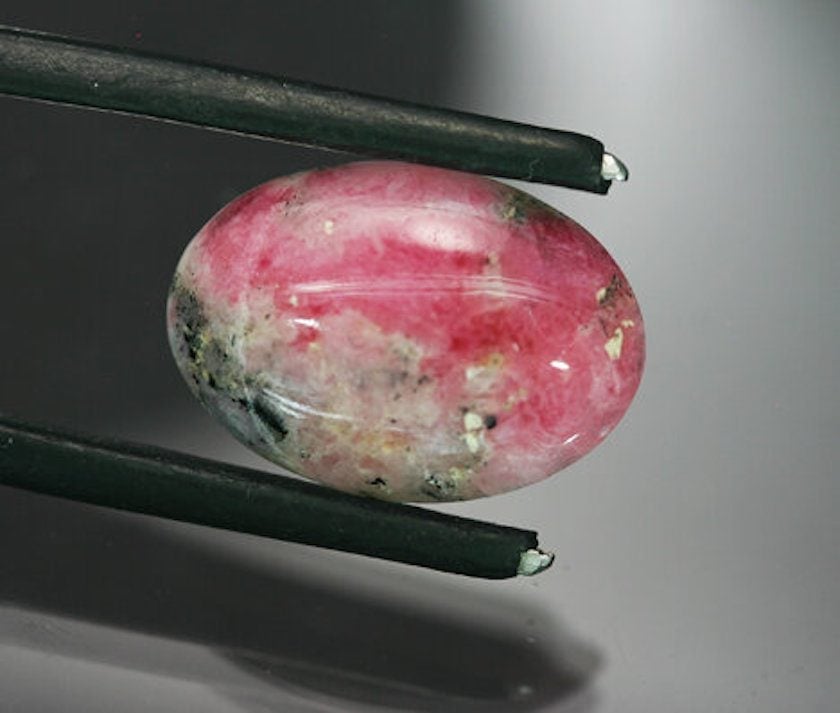Tugtupite Value, Price, and Jewelry Information
Gem collectors prize tugtupite, the "Reindeer Stone," for its rich colors and intense reaction to ultraviolet light. Sporadically used in jewelry, clean, faceted tugtupites are great rarities.
2 Minute Read
Gem collectors prize tugtupite, the “Reindeer Stone,” for its rich colors and intense reaction to ultraviolet light. Sporadically used in jewelry, clean, faceted tugtupites are great rarities.
Start an IGS Membership today
for full access to our price guide (updated monthly).Tugtupite Value
What is Tugtupite?
Discovered in 1960, tugtupites are relatively recent entries into the gem world. A member of the helvine mineral group, tugtupite is also closely related to sodalite.
You may find this mineral referred to as "Reindeer Stone," after the type locality. Tugtup means "reindeer" in the Greenlandic Inuit language. (Perhaps the gem's similarity to a certain famous reindeer's nose has also reinforced that moniker).
Do Tugtupites Glow in the Dark?
This gemstone displays striking phosphorescence and tenebrescence. Exposure to ultraviolet (UV) light, whether from artificial sources or sunlight, intensifies its colors, generally making it darker and redder. X-rays also darken paler colors. On the other hand, darkness will cause its red colors to fade. These effects are reversible.
Tugtupites can even glow in the dark after UV exposure. See "Identifying Characteristics" for more more information.
Does Tugtupite Make a Good Jewelry Stone?
The hardness of tugtupites can range from 4 to 6.5. On the softer end, a knife could scratch one. On the harder end, a specimen could exceed the hardness of more commonly encountered jewelry stones, such as feldspars. However, their distinct cleavage makes these stones better suited for pendants and earrings. Protective settings are recommended for ring use. Of course, owners should be aware of this stone's sensitivity to UV and darkness.
Moving beyond a mineral collection, these gems could make interesting Christmas jewelry pieces or glow-in-the-dark fashion statements. However, tugtupite's abundance has declined in the years since its discovery. Thus, it's become somewhat hard to obtain, especially in cuttable pieces.
Faceted pieces are extremely rare. Tugtupites are more typically cut into cabochons.
Identifying Characteristics
Luminescence
Very distinctive rose-red color. Generally redder in shortwave (SW) than longwave (LW).
- Taseq, Greenland: SW, pastel orange-red; LW, bright orange: phosphoresces bright cream or orange-cream, better reaction in SW than LW.
- Kvanefield, Greenland: LW, bright orange to orange- red; SW, cerise red, and very intense; phosphoresces dull red to medium cream white.
The material darkens in color when exposed to UV light and slowly bleaches.
A tugtupite and quartz piece under normal light, then exposed to ultraviolet light. Kvanefjeld plateau, Qeqertaussaq Island, Kangerdluarssuq Firth, Ilimaussaq complex, Narsaq, Kitaa (West Greenland) Province, Greenland. Photos by Géry Parent. Licensed under CC By-ND 2.0. (Slide show created to highlight fluorescence).
Piezoelectricity
If placed under pressure, tugtupite can generate an electrical charge.
Are There Synthetic Tugtupites?
Scientists have created synthetic analogues for this mineral. However, there is no known commercial jewelry use for this lab-created material.
Where are Tugtupites Found?
Almost all gem-quality material comes from the Taseq and Kvanefield areas of Tugtup, Ilimaussaq, Greenland.
There are only two other known sources of this rare mineral:
- Mont Saint-Hilaire, Quebec, Canada.
- Kola Peninsula, Russia.
Stone Sizes
Gem cutters have only faceted a few gems, all very small and none completely transparent. Typical gem size ranges from 1 to 2 carats. While cutters can facet translucent material, they usually cab such pieces. After the initial discovery, gem carvers made decorative objects from some of the larger tugtupites.
Caring for Tugtupite Gemstones
Store these gems separately from other harder stones such as quartz or topaz to avoid contact scratches. For cleaning, use a soft brush, mild detergent, and warm water. Avoid mechanical cleaning. Consult our gemstone jewelry cleaning guide for more recommendations.
Joel E. Arem, Ph.D., FGA
Dr. Joel E. Arem has more than 60 years of experience in the world of gems and minerals. After obtaining his Ph.D. in Mineralogy from Harvard University, he has published numerous books that are still among the most widely used references and guidebooks on crystals, gems and minerals in the world.
Co-founder and President of numerous organizations, Dr. Arem has enjoyed a lifelong career in mineralogy and gemology. He has been a Smithsonian scientist and Curator, a consultant to many well-known companies and institutions, and a prolific author and speaker. Although his main activities have been as a gem cutter and dealer, his focus has always been education. joelarem.com
International Gem Society
Related Articles
What is Gemstone Luminescence?
Black Diamond Value, Price, and Jewelry Information
Chameleon Diamond Value, Price, and Jewelry Information
Gray Diamond Value, Price, and Jewelry Information
Latest Articles
800 Years of Mogok: A Celebration in Tenuous Times
What is the Average Gemstone Faceting Yield?
Pyroxmangite Value, Price, and Jewelry Information
How to Identify Emerald Simulants and Synthetics
Never Stop Learning
When you join the IGS community, you get trusted diamond & gemstone information when you need it.
Get Gemology Insights
Get started with the International Gem Society’s free guide to gemstone identification. Join our weekly newsletter & get a free copy of the Gem ID Checklist!
